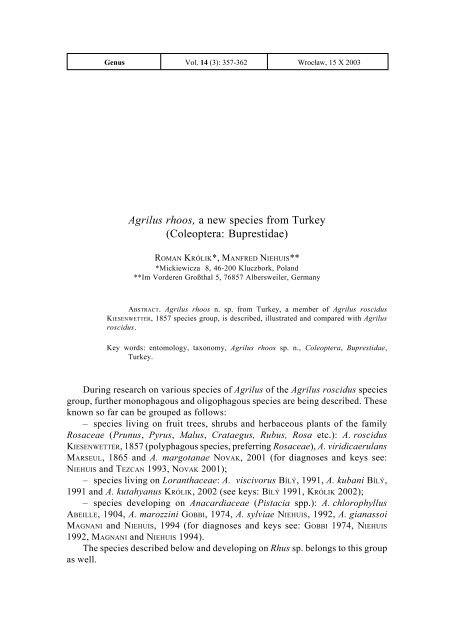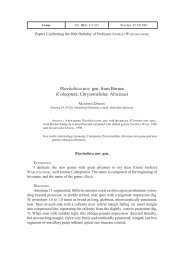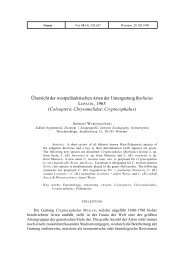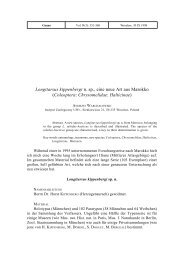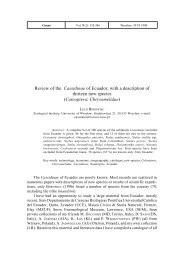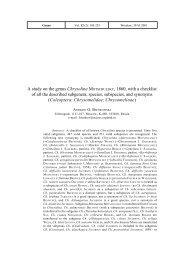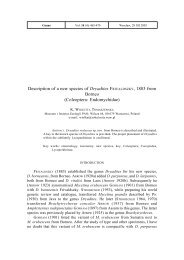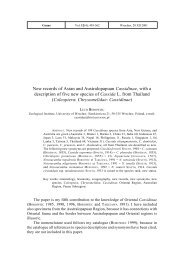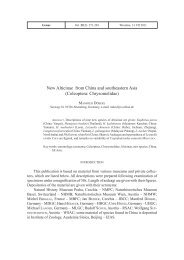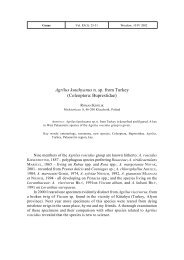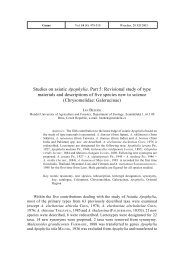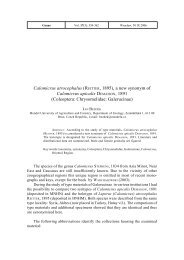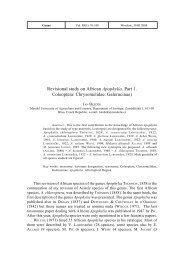Agrilus rhoos, a new species from Turkey (Coleoptera: Buprestidae)
Agrilus rhoos, a new species from Turkey (Coleoptera: Buprestidae)
Agrilus rhoos, a new species from Turkey (Coleoptera: Buprestidae)
You also want an ePaper? Increase the reach of your titles
YUMPU automatically turns print PDFs into web optimized ePapers that Google loves.
Genus Vol. 14 (3): 357-362 Wroc³aw, 15 X 2003<br />
<strong>Agrilus</strong> <strong>rhoos</strong>, a <strong>new</strong> <strong>species</strong> <strong>from</strong> <strong>Turkey</strong><br />
(<strong>Coleoptera</strong>: <strong>Buprestidae</strong>)<br />
ROMAN KRÓLIK*, MANFRED NIEHUIS**<br />
*Mickiewicza 8, 46-200 Kluczbork, Poland<br />
**Im Vorderen Großthal 5, 76857 Albersweiler, Germany<br />
ABSTRACT. <strong>Agrilus</strong> <strong>rhoos</strong> n. sp. <strong>from</strong> <strong>Turkey</strong>, a member of <strong>Agrilus</strong> roscidus<br />
KIESENWETTER, 1857 <strong>species</strong> group, is described, illustrated and compared with <strong>Agrilus</strong><br />
roscidus.<br />
Key words: entomology, taxonomy, <strong>Agrilus</strong> <strong>rhoos</strong> sp. n., <strong>Coleoptera</strong>, <strong>Buprestidae</strong>,<br />
<strong>Turkey</strong>.<br />
During research on various <strong>species</strong> of <strong>Agrilus</strong> of the <strong>Agrilus</strong> roscidus <strong>species</strong><br />
group, further monophagous and oligophagous <strong>species</strong> are being described. These<br />
known so far can be grouped as follows:<br />
– <strong>species</strong> living on fruit trees, shrubs and herbaceous plants of the family<br />
Rosaceae (Prunus, Pyrus, Malus, Crataegus, Rubus, Rosa etc.): A. roscidus<br />
KIESENWETTER, 1857 (polyphagous <strong>species</strong>, preferring Rosaceae), A. viridicaerulans<br />
MARSEUL, 1865 and A. margotanae NOVAK, 2001 (for diagnoses and keys see:<br />
NIEHUIS and TEZCAN 1993, NOVAK 2001);<br />
– <strong>species</strong> living on Loranthaceae: A. viscivorus BÍLÝ, 1991, A. kubani BÍLÝ,<br />
1991 and A. kutahyanus KRÓLIK, 2002 (see keys: BÍLÝ 1991, KRÓLIK 2002);<br />
– <strong>species</strong> developing on Anacardiaceae (Pistacia spp.): A. chlorophyllus<br />
ABEILLE, 1904, A. marozzini GOBBI, 1974, A. sylviae NIEHUIS, 1992, A. gianassoi<br />
MAGNANI and NIEHUIS, 1994 (for diagnoses and keys see: GOBBI 1974, NIEHUIS<br />
1992, MAGNANI and NIEHUIS 1994).<br />
The <strong>species</strong> described below and developing on Rhus sp. belongs to this group<br />
as well.
358 ROMAN KRÓLIK, MANFRED NIEHUIS<br />
<strong>Agrilus</strong> <strong>rhoos</strong> n. sp.<br />
(Figs 1, 2, 4, 6, 7, 10, 12)<br />
DESCRIPTION<br />
Medium sized, robust <strong>species</strong>; body length: males 4.55-7.15 mm (holotype<br />
6.00 mm), females 4.35-6.95 mm (allotype 6.35 mm). Body monochrome: olive<br />
green with greenish (male) or golden green (female) frons, or slightly two-colour<br />
– then, pronotum, scutellum and ventral side of body bluish- or golden green.<br />
Rarely elytra bluish-green. Whole body with short, white pubescence, only some<br />
part of pro- and mesosternum with longer hairs.<br />
Head large, with distinctly vaulted frons widening upwards; clypeus deeply<br />
incurved on the anterior margin, indistinctly separated <strong>from</strong> the frons; vertex<br />
wide: 0.65-0.72 times as wide as head and 3.7-5.2 times as wide as eye (fig. 4)<br />
1 – <strong>Agrilus</strong> <strong>rhoos</strong> sp. n. - holotype
AGRILUS RHOOS, A NEW SPECIES FROM TURKEY<br />
359<br />
(eye width measured along the line of head and vertex width); eyes indistinctly<br />
projecting beyond head outline, with S-shaped inner margins; frons with fine and<br />
dense puncturation and basal microsculpture, vertex with fine longitudinal grooves;<br />
antennae rather long, all antennal segments of male and 1-8 segments of female<br />
longer than wide, 4-10 triangular (figs. 6, 7).<br />
2, 4, 6-7, 10, 12. <strong>Agrilus</strong> <strong>rhoos</strong>; 3, 5, 8-9, 11. A. roscidus: 2-3 – prosternum of male, lateral view; 4-<br />
5 – head and pronotum, dorsal view; 6, 8 – male antenna; 7, 9 – female antenna; 10-11 – aedeagus;<br />
12 – ovipositor
360 ROMAN KRÓLIK, MANFRED NIEHUIS<br />
Pronotum 1.4 times as wide as long, with a slightly lobate anterior margin;<br />
lateral pronotal margins slightly incurved before posterior angles, maximum<br />
pronotal width before anterior angles (fig. 4); prehumeral pronotal keels sharp and<br />
strongly curved; medial pronotal groove vanishing in the middle, divided into a<br />
shallow and transverse anterior depression, and elongate and deeper prescutellar<br />
furrow; pronotal sculpture consisting of fine transverse wrinkles, which are finer<br />
and irregular laterally.<br />
Scutellum large, pentagonal, very finely microsculptured, with sharp transverse<br />
keel.<br />
Elytra 2.9 times longer than wide, slightly narrowed near mid-length, then<br />
distinctly enlarged in posterior third and <strong>from</strong> there regularly arched apically;<br />
sides of abdomen narrowly exposed when viewed <strong>from</strong> above; apical part of elytra<br />
with fine lateral serration; basal elytral depression deep and wide; elytral sculpture<br />
fine, tile-like.<br />
Ventral side finely and sparsely punctate, rather lustrous; anterior prosternal lobe<br />
with an indistinct median emargination, prosternal process subparallel in its middle<br />
part, then converging apically behind procoxae; anal sternite rounded apically.<br />
Legs rather long, feebly and sparsely punctate, with basal microsculpture; all<br />
tibiae flattened; claws on all legs with inner tooth.<br />
Aedeagus long and spindle-shaped, with its maximum width at apical third<br />
(fig. 10); ovipositor as in fig. 12.<br />
Sexual dimorphism. Male: antennae longer (fig. 6); frons greenish; vertex on<br />
average smaller (0.65-0.69 times as wide as head); apical part of prosternal<br />
process and medial part of mesosternum with long, erect, white hairs (fig. 2); first<br />
segment of hind tarsus with long, white bristles on its ventral side; inner teeth of<br />
tarsal claws differentiated on fore, mid and hind legs. Female: antennae shorter<br />
(fig. 7); frons golden green; vertex wider (0.67-0.72 times as wide as head); whole<br />
prosternum and mesosternum without long, white hairs; first segment of hind<br />
tarsus with short, feebly erect, black bristles; tarsal claws of all legs uniform,<br />
similar to those of hind tarsus of male.<br />
HOST PLANT<br />
Rhus sp. (Anacardiaceae).<br />
DISTRIBUTION<br />
<strong>Turkey</strong>.<br />
TYPE MATERIAL<br />
Holotype (male): Pülümür (prov. Tunceli), 17-19 VI 2002, on leaves of Rhus,<br />
leg. R. KRÓLIK. Allotype (female): the same data as holotype. Paratypes 112 exx.<br />
(65 males and 47 females): Termessos (prov. Antalya), 16-19 VII 1985, 19 exx.<br />
(15 males and 4 females), leg. M. NIEHUIS; 11 VII 1991, 2 exx. (males), leg. H.<br />
MAHR; 30 V 2002, 1 ex. (male), leg. W. and Y. STUMPF; Tekirova env., near antique<br />
Phaselis (50 km S of Antalya), 3-4 V 1991, 1 ex. (male), leg. Z. JINDRA; Alanya
AGRILUS RHOOS, A NEW SPECIES FROM TURKEY<br />
361<br />
area, Dim River (Taurus Mts.), 1-6 VII 2000, 1 ex. (female), leg. O. MEHL; Bey<br />
Daðlar , 1200 m., 30 V 2002, 1 ex. (male), leg. W. and Y. STUMPF; Gazipaºa, 180<br />
m., 29 V 2002, 1 ex. (male), leg. W. and Y. STUMPF; Erdemli (W of Mersin), 900<br />
m., 5 VI 1986, 2 exx. (females), leg. F. and K. ADLBAUER; Nurdaðý Geçidi (E of<br />
Osmaniye), 1150 m., 30 V 1986, 1 ex. (male), leg. F. and K. ADLBAUER; Kurucu<br />
Geçidi (prov. Bingöl), 22 VII 1991, 15 exx. (7 males and 8 females), leg. M.<br />
NIEHUIS; Pülümür (prov. Tunceli), 23-25 VII 1988, 7 exx. (2 males and 5 females),<br />
leg. M. NIEHUIS; 17-19 VI 2002, 28 exx. (13 males and 15 females), <strong>from</strong> branch<br />
and on leaves of Rhus, leg. R. KRÓLIK and R. DOBOSZ; 10 km N of Tunceli (prov.<br />
Tunceli), 18 VI 2002, 10 exx. (7 males and 3 females), on leaves of Rhus, leg. R.<br />
KRÓLIK and R. DOBOSZ; 10 km N of Seben (prov. Bolu), 22 VI 2002, 25 exx. (15<br />
males and 10 females), on leaves of Rhus leg. R. KRÓLIK and R. DOBOSZ.<br />
TYPE DEPOSITION<br />
Holotype, allotype and part of paratypes deposited in the Upper Silesian<br />
Museum (Bytom, Poland), other paratypes in the National Museum, Prague (Czech<br />
Republic), Museum of Natural History, Wroc³aw University (Wroc³aw, Poland),<br />
Staatliches Museum für Naturkunde, Stuttgart (Germany) and private collections<br />
Dr. S. BÍLÝ (Prague, Czech Republic), P. BRANDL (Kolbermoor, Germany), Dr. E.<br />
JENDEK (Bratislava, Slovakia), V. KUBÁÒ (Czech Republic), H. MÜHLE (München,<br />
Germany), W. STUMPF (Großliebringen, Germany), and in the author’s collection.<br />
NAME DERIVATION<br />
The specific name is derived <strong>from</strong> the name of host plant – Rhus.<br />
DIFFERENTIAL DIAGNOSIS<br />
A. <strong>rhoos</strong> sp. n. belongs to the <strong>Agrilus</strong> roscidus group, where it is most similar<br />
to A. roscidus. It differs <strong>from</strong> it in the following characteristics:<br />
<strong>Agrilus</strong> roscidus <strong>Agrilus</strong> <strong>rhoos</strong> sp. n.<br />
Body smaller; length 4-6.5 mm larger; length 4.35-7.05 mm<br />
Antennae shorter; segments 6-8wider longer; segments 6-8 longer<br />
than long (figs 8-9) than wide (figs 6-7)<br />
Eyes distinctly projecting beyond indistinctly projecting beoutline<br />
of head (fig. 5) yond outline of head (fig. 4)<br />
Vertex narrower, ca 0.65 times as wide wider, 0.65-0.72 times as wide<br />
as head. Vertex ca 3.5 times as as head (male 0.65-0.69,<br />
wide as eye (fig. 5) female 0.67-0.72). Vertex of<br />
female 4.1-5.2 times as wide<br />
as eye (fig. 4)<br />
Lateral margins more rounded, maximum pro- more straight, maximum proof<br />
pronotum notal width at anterior third notal width before anterior<br />
(fig. 5) angles (fig. 4)
362 ROMAN KRÓLIK, MANFRED NIEHUIS<br />
Anterior and mid with long white hairs (fig. 3) with extremely short hairs<br />
part of male<br />
prosternum<br />
(fig. 2)<br />
Aedeagus more robust, with its maximum slender, with its maximum<br />
width at apical quarter (fig. 11) width at apical third (fig. 10)<br />
Host plant polyphagous <strong>species</strong> preferring<br />
fruit trees or shrubs (Prunus,<br />
Pyrus, Malus, Crataegus etc.)<br />
Rhus<br />
REFERENCES<br />
GOBBI, G., 1974. Il gruppo dell’<strong>Agrilus</strong> roscidus Kiesw. in Italia e descrizione di una nuova specie<br />
(<strong>Coleoptera</strong>, <strong>Buprestidae</strong>). Fragm. Entomol., 9:253-262.<br />
BÍLÝ, S., 1991. Two <strong>new</strong> <strong>species</strong> of <strong>Agrilus</strong> roscidus <strong>species</strong>-group <strong>from</strong> central Europe (<strong>Coleoptera</strong>,<br />
<strong>Buprestidae</strong>). Acta Entomol. Bohemoslov., 88: 371-375.<br />
KRÓLIK, R., 2002. <strong>Agrilus</strong> kutahyanus n. sp. <strong>from</strong> <strong>Turkey</strong> (<strong>Coleoptera</strong>: <strong>Buprestidae</strong>). Genus, 13: 25-<br />
31.<br />
MAGNANI, G., NIEHUIS, M., 1994. Un nouvel <strong>Agrilus</strong> de Chypre (<strong>Coleoptera</strong>, <strong>Buprestidae</strong>). Biocosme<br />
Mesogéen, Nice, 11: 49-52.<br />
NIEHUIS, M., 1992. <strong>Agrilus</strong> sylviae n. sp. ein neuer pistaciophager <strong>Agrilus</strong> aus dem Nahen Osten<br />
(<strong>Coleoptera</strong>: <strong>Buprestidae</strong>). Mitt. internat. entomol. Ver., 17: 209-217.<br />
NIEHUIS, M., TEZCAN, S., 1993. Beitrag zur Kenntnis der <strong>Agrilus</strong>-Arten der Türkei (<strong>Coleoptera</strong>:<br />
<strong>Buprestidae</strong>). Mitt. internat. entomol. Ver., 18: 1-74.<br />
NOVAK, G., 2001. <strong>Agrilus</strong> margotanae n. sp., eine neue Art der <strong>Agrilus</strong> roscidus-Gruppe aus Zypern<br />
(<strong>Coleoptera</strong>, <strong>Buprestidae</strong>). Zeitschrift der Arbeitsgemeinschaft Österreichischer Entomologen<br />
53: 53-56.


